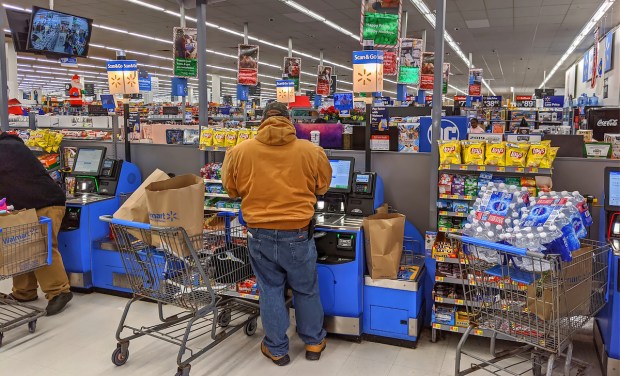Amazon and Walmart Rethink Self-Checkout to Manage Costs

As retailers look to find the right combination of technology and human labor to boost their profit margins, Amazon and Walmart have both made changes to how they approach self-checkout in stores.
Amazon is replacing its Just Walk Out technology at Amazon Fresh stores with its smart shopping cart, the Amazon Dash Cart.
“We’ve … heard from customers that while they enjoyed the benefit of skipping the checkout line with Just Walk Out, they also wanted the ability to easily find nearby products and deals, view their receipt as they shop, and know how much money they saved while shopping throughout the store,” Jessica Martin, a spokesperson for the eCommerce giant, said in a statement emailed to PYMNTS Tuesday (April 2).
The high cost of the technology may have played a role, equipping a full-sized grocery store with computer vision technology versus smart carts, which only rely on the artificial intelligence imaging and sensors in a much smaller area.
Additionally, the system may not have been as autonomous as it claimed to be. It reportedly relied on more than 1,000 workers in India remotely monitoring deployments to make sure that checkouts were accurate, although the company told Engadget that it “has continued to scale while reducing the number of human reviews year over year.”
Amazon is not the only retailer increasing its smart cart presence. In recent weeks, Instacart and Associated Wholesale Growers (AWG) shared that they had expanded their partnership to 2,300 more AWG member retailer locations, which includes offering more direct access to Instacart’s AI-powered Caper Cart self-checkout carts.
Plus, A2Z Smart Technologies Corp. announced the first deployment of its Cust2Mate 3.0 smart carts, scheduled to go live in April in Israel’s Yochananof supermarket chain, with France’s Monoprix and the United States’ Morton Williams to follow.
Meanwhile, reports last month showed Walmart scaling back self-checkout, either limiting it to subscribers or making it a store-by-store decision.
“During these times of limited access, some stores are designating select self-checkout stations for Walmart+ customers using our Scan and Go service and Spark drivers for quicker access and delivery services,” a Walmart spokesperson told PYMNTS at the time. “This decision is intended to better manage checkout availability.”
Many retailers have been scaling back their self-checkout efforts amid ongoing challenges with theft. These changes mark a turn from retailers’ earlier enthusiasm for the technology. PYMNTS Intelligence’s “Big Retail’s Innovation Mandate: Convenience and Personalization” revealed that 60% of U.S. retailers thought consumers would be very or extremely likely to switch merchants if not offered self-service kiosks.
As for shoppers, many want the convenience of self-checkout. Findings highlighted In PYMNTS Intelligence’s “Retail Tracker®: Innovating the Retail Checkout Experience” noted that more than half of consumers expect to see self-service kiosks in place and available when they shop in brick-and-mortar settings.
In the world of retail, the changes in how Amazon and Walmart handle self-checkout reflect the ongoing challenge of meeting customer needs while managing costs effectively.
For all PYMNTS retail coverage, subscribe to the daily Retail Newsletter.

